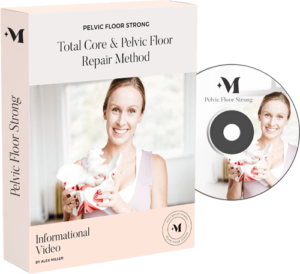You might have heard about Kegel exercises for women but under the name pelvic floor exercise. Yes, this exercise is designed specifically for our pelvic floor muscles. In 1950, Arnold Kegels, a gynecologist from the University of Southern California, created this method to strengthen the pelvic floor.
Ever since, it has been considered the best way to heal or prevent pelvic floor dysfunction and other bladder problems. Whether you are pregnant, planning to get pregnant, in postpartum, or undergoing natural menopause, doctors will always recommend you to do this exercise. Searching on the internet, you would find countless articles showing how to do a “proper” Kegel session. Perhaps you, too, have been practicing it for months.
But wait, let me ask you some questions.
Have you ever thought about whether or not Kegels is suitable for you? What if the ultimate method everyone talks about doesn’t help you that much?
Is there any better, more effective way to improve your pelvic floor muscles than Kegels?
In this guide on Kegels’ exercise for women, we will reveal the answer to all of the questions above. Trust me when I say that there are many things you don’t know about this method. Together, let’s go through each of them and see if Kegels can really help you!
What Are Kegel Exercises For Women? How Can It Help You Strengthen The Pelvic Floor?
In short, Kegel is a repetitive exercise of squeezing and holding your pelvic muscles continuously for 3-10 seconds, followed by releasing and relaxing the muscles. The method aims to promote muscle tone by training the pubococcygeus muscles that form the pelvic floor. From there, it takes effect in boosting the flexibility of these muscles, helping you gain control of your urination and tackle bladder leakage.
However, as you contract and release the pelvic floor while doing Kegels, you are not working on pubococcygeus muscles alone but also affecting the whole pelvic diaphragm. Also known as levator ani, the pelvic diaphragm consists of two more groups, puborectalis, and iliococcygeus. That’s why its benefits are more than just improving pelvic floor dysfunction. Aside from that, Kegels also promote sexual gratification, allowing women to complete pompoir and making it easier to reach an orgasm. Furthermore, it helps prevent vaginal prolapse and uterine prolapse.
Since Kegel is an internal exercise, you can practice it without having to move your whole body. That’s one of the reasons the method becomes so popular: Even pregnant and nursing women can practice it and enjoy all the benefits it delivers. What’s more, Kegels can assist with labor and delivery. As your muscles become more flexible to bear the baby’s weight, you can go through a shorter labor phase and lower the chance of vaginal tears. For more benefits of Kegels exercise when pregnant, read this post!
How To Do The Kegel Exercises Properly?
In reality, the Kegels exercise is simple. To practice it, you lift, hold, then relax your pelvic floor muscle. Even though it sounds easy, you shouldn’t strain yourself. Instead, begin with a few exercises for a while. Then, gradually lengthen the time and increase the number of movements you can perform each set.
Suppose you have never tried exercising your pelvic floor before, you can start by lifting and holding for three seconds, then relax for another three seconds. Doctors often recommend you doing this repetitively 10 times in a row – that would be one set. You should perform at least two sets a day. As you improve, you can lengthen each lifting, holding, and relaxing time and increase the number of movements making up a set and the number of sets you can do per day.
We have to leave a warning here, though: Many women forget to consult their doctors or physicians before increasing the number of sets they can do per day. While this sounds unimportant, overtraining your pelvic floor muscles can make them worn out and lead to more harmful consequences. There is nothing to be embarrassed about here: Do talk to a professional before adjusting the intensity of the exercise. It’s just one of the fatal mistakes most people make while doing Kegel exercises for women. We shall discuss the other mistakes in the next part.
Signs You Might Be Doing Kegel The Wrong Ways.
According to surveys, around 30% of women have been doing Kegel the wrong way. It is an alarming number. Although you couldn’t even see the muscles, it makes sense since many people don’t know what they are doing and which part of their bodies is working. Below are some common signs you might be performing Kegels incorrectly:
- Instead of improving, your pelvic floor symptoms seem to get worse than before.
- After completing a Kegels exercise session, you experience pains in the lower back or abdominal area.
- You feel new pain while doing sexual intercourse or experience negative changes while having sex.
- The body develops new tailbone pain or pain while sitting.
If you see one of these signs, you might want to immediately seek help from your doctor or physician.
Chances are you have made one or more mistakes in this list:
- Clench or contract the wrong muscles. When being told to squeeze and relax the pelvic floor muscles, most patients often contract their abdominals, buttocks, or thigh muscles instead. Keep in mind that tightening up your glutes is not a Kegel, and it does nothing in improving your pelvic floor! The worst mistake is straining and pushing down as if moving one’s bowel. It is precisely the opposite of Kegel’s exercise, as it should cause an inward and upward lift. It causes pain to surrounding muscles and over-stretches the pelvic floor muscles, worsening the condition.
- Strengthen at the wrong time. Many people assume that they should practice Kegels while urinating, but regularly interrupting urine flow can lead to urinary tract infection.
- Hold your breath. The pelvic floor muscles are the floor of the core group of muscles: The diaphragm on top, the abdominals on the front and sides, the Kegel muscles on the bottom, and the spinal muscles in the back. As you hold your breath, you are pressing the diaphragm down. It adds to the intra-abdominal pressure and pushes down the pelvic floor, precisely the opposite way you want it to move.
- Overtrain the muscles. Two reasons can lead to this: You perform Kegel too frequently, as mentioned above, or forget to release after contracting.
Overall, all of these mistakes make it pointless to practice Kegels. Worst of all, they can further harm your pelvic floor and lower back muscles in the long run.
Cases When Kegel Exercises For Women Might Not Be The Answer.
If you have been making the mistakes above for a long time, chances are you have caused further harm to your pelvic floor. In this case, we recommend you stop immediately and seek medical help from a professional. Once you have experienced one of the symptoms above, any attempt to retry Kegel can be bad for your pelvic floor muscles.
Other than that, there are two cases when Kegels is not your solution:
-
You have an overactive pelvic floor.
There are two types of pelvic floor dysfunction: Underactive and overactive. Kegel exercises for women, if done correctly, can provide significant benefits to people with an underactive pelvic floor. However, it is the exact opposite of what you need if you fall into the latter category. The method involves repetitive movements of your pelvic floor muscles, enhancing their stiffness. Over time, it will lead to a hypertonic pelvic floor, worsening the problem. Therefore, it is essential to know the type of your dysfunction before performing Kegel.
-
You might need more than Kegel to solve your problem.
Even if you have been practicing Kegel correctly, some pelvic floor disorders require more than Kegel to solve. As mentioned, the pelvic floor works in association with other muscles that form the “inner core”. Together, they control the pressure within the pelvis and abdomen to stabilize the trunk of our bodies while moving. Hence, it is crucial to address the proper recruitment and coordination of these muscles for most cases.
Recent studies show that women who undergo pelvic physiotherapy can improve incontinence better than those who only perform Kegel. To heal from the condition, you need whole-body exercises, manual therapy, and education on postural aside from internal exercises.
In That Case, Here Is The Comprehensive Solution For You.
Created by a well-known expert in physiology, Pelvic Floor Strong can be considered an encyclopedia on healing from pelvic floor dysfunction.
The program contains both reading and watching materials that show you everything. It explains how to evaluate your symptoms and understand which types of pelvic floor dysfunction you have. Then, it guides you on the correct techniques to perform internal exercises and introduces whole-body activities to make the healing progress faster. Most importantly, it corrects your postures and breathing techniques so you will never damage your lower body by accident.

>>> Click Here To Get Instant Access To Pelvic Floor Strong <<<
Linkingo has tried and tested Pelvic Floor Strong before concluding that it is the most comprehensive guide on pelvic floor dysfunction available. The program has helped more than 168,000 women worldwide to get back their confidence, and I am sure you will be the next.
If you want to learn more about Pelvic Floor Strong, you can check out Linkingo’s complete review of the program here. Our team had spent many hours researching and experiencing it before giving our detailed analysis. After reading our review, you will know whether it is suitable for you. Still, if you have any questions regarding the program, you can always leave a comment below, and we will get back to you as soon as we can!
Tips For Safe Kegels Exercise.
At the end of this guide on Kegel exercises for women, Linkingo would like to show you some safety tips:
- Consult your doctor first to know whether Kegels is the right solution for you.
- Don’t forget to find out the right muscles before performing the exercise. Our previous post introduced some of the simple methods to identify your pelvic floor muscles. You can also ask your doctor or physician for help.
- While the exercise can be performed in all positions, if your pelvic floor is weak, you might want to lie down first.
- When starting, only do the number of movements that are easy for you.
- Do not hold your breath while doing Kegels exercise – breathe out! Also, be careful not to tighten your inner thighs, back, buttocks, or stomach.
Kegels Exercises For Women – A Summary.
The benefits Kegel exercise can bring to a woman’s body cannot be denied. However, since it is an internal exercise, Kegel does have its limitations. For example, it is not easy for you to know whether you are performing the proper techniques or not. Therefore, those want to do the exercise by themselves, in the comfort of their homes, Kegel can be challenging. What’s more, it is not suitable for anyone and can backfire if you do not research carefully before practicing.
In that case, perhaps it’s time for you to seek help from other modern, innovative methods and only consider Kegels a supportive exercise instead of the “ultimate solution for pelvic floor dysfunction”. One of the methods that can be beneficial for you is the Pelvic Floor Strong program as mentioned above.
Find this article helpful? Please share it with those in need because sharing is caring! Your feedback helps Linkingo improve our website, so we look forward to receiving your comment below.
We look forward to seeing you in our next posts!






Leave a Reply